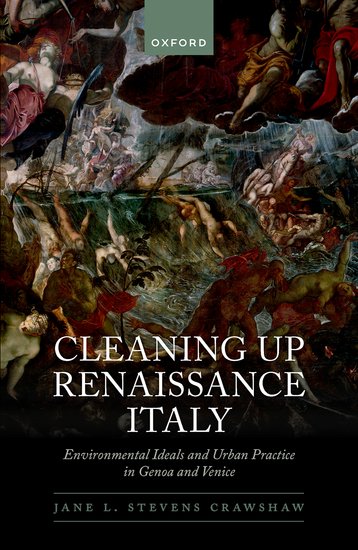


Reviewer Janna Coomans - Universiteit Utrecht
CitationFrom accidents with speeding carts, rotten food as a cause of plague, sunken ships clogging up the harbour to the massive demand for fresh water by thirsty naval merchants: keeping an Italian Renaissance port city functional healthy and thriving was a continuous and difficult task. Jane L. Stevens Crawshaw’s Cleaning Up Renaissance Italy reconstructs these daily and recurring challenges. It thus offers an important contribution at a crossroads of socio-cultural, urban, and environmental history. The book historicizes environmental management by examining how two cities, Venice and Genoa, variously responded to challenges during mainly the sixteenth century. Through a comparative synthesis, Crawshaw explores how these two cities shaped their sanitary practices, informed by their distinct topographies. Her work adds to revisionist scholarship that argues against traditional views of premodern urban environments as neglected and unsanitary, presenting instead a picture of extensive efforts to maintain cleanliness and order.
Crawshaw’s aim is to contextualize environmental management within the framework of Renaissance urban social governance and culture. These cities’ policies were not simply reactive but rooted in ideals of flow, balance, and cleanliness. The concept of an orderly urban body – where regulated movement of water, goods, and people was key – served as both a practical and symbolic ideal. Health issues were compounded not only by environmental vulnerability but also by social composition, including mobility, occupation, and poverty. Crawshaw’s study also convincingly emphasizes the convergence of practical with moral and religious considerations. For instance, spiritual associations with natural disasters, such as rites for saints during storms and cults dedicated to Mary of the Sea, illustrate such intertwining of practical and spiritual concerns. The book integrates Anglo-Saxon and Italian scholarship on Venice (which is particularly abundant) and Genoa (which is less explored). Crawshaw draws on a wealth of sources, including Genoese requests and proclamations, Venetian letters of supplication, and records from designated health and public works officials, to build a comparative narrative. Expert officials were consulted in both cities to address environmental challenges, and how communication methods, such as town criers and in-household dissemination, helped enforce regulations.
The book is organized into six chapters, divided into two parts, alongside an introduction and conclusion. Chapter 1 establishes the ideals and practices of Renaissance port cities, focusing on how these informed approaches to cleanliness and public health. Part One, «The Ebbs and Flows of Daily Life», examines the management of movement and purity, including the regulation of streets and water management through symbolic and practical measures to ensure cleanliness. Innovations and purgation efforts to combat waste and siltation are also explored. Part Two, «Balance and Blame», shifts focus to waste management and responses to disasters, examining how urban spaces were reused and managed to maintain balance, and how environmental, social, and religious responses to crises intersected.
Crawshaw’s many examples bring Renaissance environmental management to life. Extensive dredging works were undertaken in both cities to combat siltation, supported by patents, and even lotteries. In Venice, the regulation of streets and bridges – key bottlenecks for movement – was prioritized, addressing issues like malodorous muddy spaces around wells, blocked alleys, dangerous balconies, and even slippery stones. Genoa’s aqueduct system, along with cisterns and water boats, exemplifies the plurality of water supply solutions. Having multiple sources of fresh water supply was equally essential in Venice. The book also examines waste management practices, including the instalment of communal rubbish containers and (briefly) the night soil trade. Crawshaw highlights the involvement of diverse laborers, from fishermen and porters to muleteers, in handling waste or, for instance, salvaging shipwrecks.
Environmental management in Venice and Genoa was a combination of technological innovation and social policies. With slight differences in policies, both cities achieved a degree of success in daily management and large-scale interventions like dredging projects. While Venice’s policies emphasized collective interests, Genoa’s approach relied more on local organization and private-public collaboration. The book underscores the agency attributed to nature and the emotional responses it evoked, framing environmental management as both a practical and symbolic endeavour. Crawshaw sees no significant changes in environmental management approaches in response to disasters. Instead, the focus was on reducing their impact and frequency. This conclusion raises questions about the definition of “disaster” in the Renaissance context and how it shaped urban policies.
Furthermore, several aspects invite further discussion. Crawshaw’s linkage of ideals to practice could in some respects be more fully substantiated. While she discusses a range of interventions, the extent to which these measures were enforced remains at times unclear. For instance, were the cleaning efforts consistently carried out, or were they more aspirational? The focus on qualitative over quantitative analysis leaves open questions about the effectiveness and prioritization of environmental policies compared to other urban concerns. The book also leaves the reader curious about the relative financial and political investments in environmental management compared to other priorities of urban governments. Such analysis would strengthen Crawshaw’s claim that public health and cleanliness were central to urban governance. Additionally, while the convergence of practical and spiritual interests is a compelling theme, it would be interesting to explore whether these associations changed over time, particularly in response to evolving environmental challenges. Nonetheless, Cleaning Up Renaissance Italy is a significant and welcome contribution that challenges longstanding narratives of premodern urban neglect and reconstructs proactive urban efforts to manage cleanliness and health. The book’s wide range of fascinating topics and integration of diverse historiographies make it a valuable resource for scholars of Renaissance cities and environmental history.